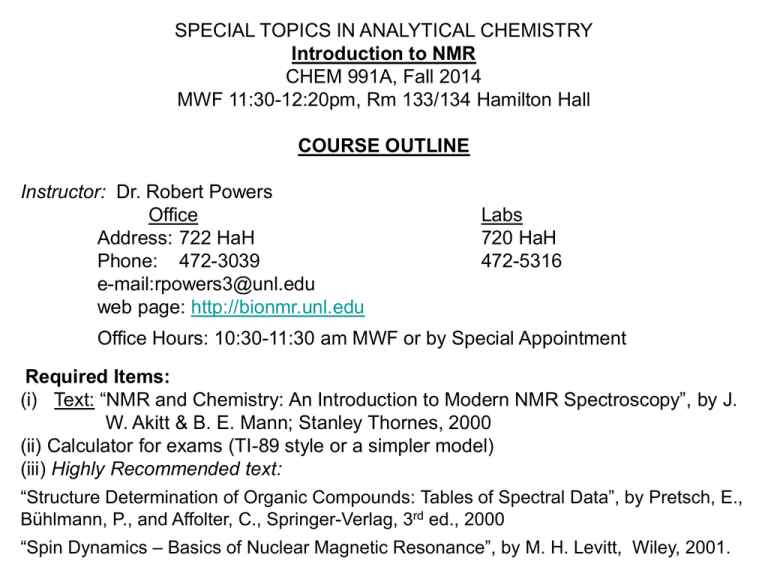
SPECIAL TOPICS IN ANALYTICAL CHEMISTRY
Introduction to NMR
CHEM 991A, Fall 2014
MWF 11:30-12:20pm, Rm 133/134 Hamilton Hall
COURSE OUTLINE
Instructor: Dr. Robert Powers
Office
Address: 722 HaH
Phone: 472-3039
e-mail:rpowers3@unl.edu
web page: http://bionmr.unl.edu
Labs
720 HaH
472-5316
Office Hours: 10:30-11:30 am MWF or by Special Appointment
Required Items:
(i) Text: “NMR and Chemistry: An Introduction to Modern NMR Spectroscopy”, by J.
W. Akitt & B. E. Mann; Stanley Thornes, 2000
(ii) Calculator for exams (TI-89 style or a simpler model)
(iii) Highly Recommended text:
“Structure Determination of Organic Compounds: Tables of Spectral Data”, by Pretsch, E.,
Bühlmann, P., and Affolter, C., Springer-Verlag, 3rd ed., 2000
“Spin Dynamics – Basics of Nuclear Magnetic Resonance”, by M. H. Levitt, Wiley, 2001.
Some Other Suggested NMR References
“Spectrometric Identification of Organic Compounds” Silverstein, Bassler
and Morrill
“Organic Structure Determination Using 2-D NMR Spectroscopy: A
Problem-Based Approach” Jeffrey H. Simpson
“Essential Practical NMR for Organic Chemistry” Stephen A. Richards &
John C. Hollerton
“Basic One- and Two-Dimensional NMR Spectroscopy” Horst Friebolin
“Modern NMR Techniques for Chemistry Research” Andrew E. Derome
“Nuclear Magnetic Resonance Spectroscopy” R. K Harris
“Experimental Pulse NMR. A Nuts and Bolts Approach” Eiichi Fukushima
& Steve B.W. Roeder
“Two-Dimensional Nuclear Magnetic Resonance in Liquids”, Ad Bax
Some NMR Web Sites
The Basics of NMR by J.P. Hornak Hypertext based NMR course
http://www.cis.rit.edu/htbooks/nmr/nmr-main.htm
Spectral DataBase for Organic Compounds (SDBS)
http://sdbs.db.aist.go.jp/sdbs/cgi-bin/cre_index.cgi
Educational NMR Software
All kinds of NMR software
http://deane.bio.ucalgary.ca/EduNMRSoft.html
NMR Knowledge Base
http://www.spectroscopynow.com/
A lot of useful NMR links
NMR Information Server
http://www.spincore.com/nmrinfo/
News, Links, Conferences, Jobs
Technical Tidbits
http://www.acornnmr.com/nmr_topics.htm
Useful source for the art of shimming
NMR Wiki
Sharing NMR know-how
http://nmrwiki.org/wiki/index.php?title=Main_Page
Some More NMR Web Sites
Structure Determination Using NMR by H. J. Reich
Web based NMR course
http://www.chem.wisc.edu/areas/reich/chem605/index.htm
eNMR
NMR Periodic Table
http://www.bruker-nmr.de/guide/eNMR/chem/NMRnuclei.html
Web Spectra
http://www.chem.ucla.edu/~webspectra/
Example NMR Structure Problems
Organic Structure Elucidation
Another Work Book of Unknowns
http://www3.nd.edu/~smithgrp/structure/workbook.html
NMRShiftDB2
Predict NMR Chemical Shifts
http://nmrshiftdb.nmr.uni-koeln.de/nmrshiftdb
ChemDoodle
Simulate NMR and MS Spectra
http://web.chemdoodle.com/demos/simulate-nmr-and-ms
NESG Wiki
Another NMR Wiki Page, Emphasis in Protein NMR
http://www.nmr2.buffalo.edu/nesg.wiki/Main_Page
Lecture Topics
I.
II.
III.
IV.
Topic
Chapters in NMR & Chemistry
BASIC NMR Theory
I.
Introduction to NMR Theory
1
a. Quantum and classical description
II. Obtaining an NMR Spectra
5
a. Data acquisition and processing
b. Instrumentation
III. Chemical Shifts (d)
2
a. Select examples of chemical shift trends
b. Predicting chemical shifts
IV. Coupling Constants (J)
3
a. Simulation of second-order spin systems
One and Two Dimensional NMR
I.
NMR Pulses
6
II. 1D NMR
8
a. NOE, J modulation, INEPT, DEPT, INADEQUATE
III. 2D NMR
9
a. Theory
b. COSY,TOCSY,NOESY,HMQC,HMBC
IV. Examples of Spectral Interpretation
8
NMR Dynamics
I.
Relaxation
4
a. T1,T2,Dipole-Dipole,CSA,Quadrupolar
II. Exchange
7
a. NMR time scale
Solid State NMR (as time permits)
11
Course Outline
Chapter
Date
I. Basic NMR Theory
Aug 25
Aug 27
Aug 29
Sep 3
Sep 5
Chap 1
Sep 8
Chap 1
Sep 10
Chap 1
Sep 12
Chap 5
Sep 15
Chap 5
Sep 17
Chap 5
Sep 19
Chap 5
Sep 22
Chap 5
Sep 24
Chap 2
Sep 26
Chap 2
Sep 29
Chap 2
Oct 1
Chap 2
Oct 3
Chap 3
Oct 6
Chap 3
Oct 8
Chap 3
Oct 10
Midterm Exam
Oct 13
Chap 6
Oct 15
Chap 6
II. One and Two Dimensional NMR
Oct 17
Chap 8
Topic
Course Overview & Scheduling
Software Lab
Software Lab
Software Lab
Introduction to NMR Theory
Obtaining an NMR Spectrum
Chemical Shifts (d)
Coupling Constants (J)
NMR Pulses
1D NMR
Date
Chapter
Topic
Oct 20 to Oct 21
Fall Break
Oct 22
Chap 8
Oct 24
Chap 8
Oct 27
Chap 8
Oct 29
Chap 9
2D NMR
Oct 31
Chap 9
Nov 3
Chap 9
Nov 5
Chap 9
Nov 7
Examples of Spectral Interpretations
III. NMR Dynamics
Nov 10
Chap 4 & 7
Relaxation & Exchange
Nov 12
Chap 4 & 7
Nov 14
Chap 4 & 7
Nov 17
Chap 4 & 7
IV. Solid State NMR
Nov 19
Chap 11
Solid State NMR
Nov 21
Chap 11
V. Presentations of NMR Papers
Nov 24
Oral Presentations
Nov 26 to Nov 28
Thanksgiving Break
Dec 1
Oral Presentations
Dec 3
Oral Presentations
Dec 5
Oral Presentations
Dec 8
Oral Presentations
Dec 10
Oral Presentations
Dec 12
Review Structure Problem Sets Due
Dec 16
Final Exam
Course Outlined (cont.)
Course Work:
Midterm Exam:
Final Exam:
Structure Problems (3):
Oral Presentation:
Total:
100 pts.
100 pts.
150 pts.
50 pts.
400 pts.
(Fri., Oct. 10)
(Tues., Dec. 16)
(Fri., Dec. 12)
(various due dates)
ALL PowerPoint presentations, grades, and answer keys for the structure
problem sets and exams will be posted on BlackBoard.
Grading scale: A+=95%; A=90%; A-=85%; B+=80%; B=75%; B-=70%;
C+=65%; C=60%; C-=55%; D=50%; D-=45%; F=40%
Course Outlined (cont.)
Class Participation
• Reading assignments should be completed prior to each lecture.
• You are expected to participate in ALL classroom discussions
Exams
• The MidTerm Exam will take place at 6 pm on Fri. Oct. 10 in Rm 133/134
Hamilton Hall. The Final Exam will take place at 10 am on Tues. Dec. 16
in Rm 133/134.
• The length of each exam will be two hours. The Final Exam WILL NOT be
cumulative, it will only cover new material since the MidTerm Exam.
• Bring TI-89 style calculator or a simpler model, and a approved translator
if needed.
• A review session will take place during the normal class time.
• ALWAYS SHOW ALL WORK!!!!
STRUCTURE PROBLEMS
• Using NMR Data to Determine the Structure of an
Unknown Organic Compound
• Total of 3 unknown structures to solve
• Structures will be randomly assigned to you today
• NMR data sets for unknowns will be available in the NMR computer
lab (832 HaH)
• Each unknown will include the following data:
– Chemical formula
– 1D 1H & 13C spectra
– 2D 1H COSY, 2D 1H NOESY, 2D 1H-13C HSQC, 2D 1H-13C HMBC, 2D
HSQC-TOCSY
• Each Structure Problem Sets Increase in Difficulty
– First unknown – easy
– Second unknown – moderately challenging
– Third unknown – difficult
• Do Not Wait! Start Working on the Problem Sets Now!
STRUCTURE PROBLEMS (cont.)
• Using NMR Data to Determine the Structure of an
Unknown Organic Compound
• Assign Each Student Their Three Unknowns
STRUCTURE PROBLEMS (cont.)
• The Goal of the Structure Problem Sets is to Develop Your
Skills in Analyzing NMR Data
•
•
•
•
These are Individual Projects
Do Not Work Together on the Assignments
Do Not Share Your Results with Other Students
Answer Keys will be Posted after Class on Fri. Dec 12
• The Due Date for the Three Structure Problems is the
beginning of class on Friday, Dec. 12
• Please Hand-in Your Answers as Soon as You Complete the
Assignment
• Problems Sets will be Graded as they are turned-in and Grades will be
Immediately Posted on BlackBoard
• A Significant Component of Your Grade is Your Performance on these
Problem Sets.
• Don’t Wait Until the End of Class to Determine If you Are Having
Problems! - Seek Help and Visit Me during My Office Hours
• Grading (50 points/structure; 150 total points)
STRUCTURE PROBLEMS (cont.)
• Completed Reports for the Unknown Structure
Determination will contain:
• Your Name
• Unknown Number
• Chemical Structure of the Unknown
Grade will Simply be Based on
the Accuracy of Your Identified
Structure
- Any partial credit awarded for
an incorrect structure is strictly
subjective and is not open to a
re-grade
STRUCTURE PROBLEMS (cont.)
• Software Training
• In order to complete the structure problem sets, you will need to
know how to use NMR software to analyze the NMR data.
• The software training will take place in the NMR computer lab (Rm
832)
• For the next THREE lectures (Aug 27 to Sept. 3) Please go to HaH
832 for Software Training.
• Dr. Martha Morton will oversee the software training.
• Questions on the MidTerm Exam Will Cover Material Discussed
During the Software Training Sessions.
Input data
(ser file)
SP
ZF
FT
PS
TP
STRUCTURE PROBLEMS (cont.)
• NMR Training
• The application of two-dimensional (2D) NMR will be a major focus
of the course and an important component of the structure problems
• In addition to the software training, you will also receive one hour of
hands-on training with Dr. Morton on an NMR spectrometer.
• The training will involve practical information for setting-up and
executing 2D NMR experiments.
• The training will occur in groups of 3-4 students on various dates
based on Dr. Morton’s availability
• Questions on the MidTerm Exam Will Cover Material
Discussed During the NMR Training Session.
STRUCTURE PROBLEMS (cont.)
• NMR Training (cont.)
• SCHEDUAL NMR TRAINING
• Doodle poll – First come, First Serve.
ORAL PRESENTATION OF AN NMR PAPER
– One 20 minute Oral Presentation in Class
• Last Two Weeks of the Semester (Nov. 24 to Dec. 10)
• Audience Participation is Expected (like a journal club)
• Presentation Dates Randomly Assigned Today
• Grading: 50 points
– Paper of Your Choice (two options):
• Paper Describes an NMR method (i.e., pulse sequence, software, or
strategy) to Determine the Structure of an Organic Molecule
CAN NOT be a Method Discussed in Class
or
• Paper Describes the Determination of the Structure of an Organic
Molecule or Natural Product that Primarily Used NMR
– Some Other Considerations:
• The Paper Topic Should be of General Interest and of Significant Impact
• Send an Electronic Copy of the Paper to the Class Prior to Your
Presentation
ORAL PRESENTATION OF AN NMR PAPER (cont.)
SCHEDUAL ORAL PRESENTATIONS
– Some Recommended Sources
• JACS, J. Mag Res., Concepts in Magnetic Resonance,
Progress in Nuclear Magnetic Resonance Spectroscopy,
Anal. Chem., J. Med. Chem. PNAS, Journal of Organic
Chemistry, Organic Letters, Angewandte Chemie, and
Angewandte Chemie International Edition, ChemMedChem,
and Natural Products Reports.
ORAL PRESENTATION OF AN NMR PAPER (cont.)
– Presentation Goals
NMR Method Paper
•
•
•
•
•
Present a Clear Understanding of the NMR Method(s) to the Class
How is the Method Used to Solve a Structure?
What are the Advantages and/or Limitations of the Method?
How Does the Method Compare to Alternative Approaches?
Why Did You Choose the Paper?
Structure Paper
•
•
•
•
•
Explain to the Class, in Detail, How NMR was Used to Determine
the Structure
Explain the NMR Experiments Used and the Information the
Experiments Provided.
Why is the Compound of Interest?
What were Challenges to Solving the Structure?
What Other Analytical Techniques were Used to Solve the
Structure and Why?
ORAL PRESENTATION OF AN NMR PAPER (cont.)
– Grading
•
•
•
•
Combination of My Assessment and the Other Students’ Assessment
Each Student will be Limited to Giving Approximately 30% As, 55%
Bs, and 15% Cs
Default Grade is a B, a A or C will Require Justification
All the assessments will be averaged together to determine the
number of points
Average Assessed Grade: A to A-: 50pts, B+: 45pts, B to B-: 40pts, C+: 35pts, C: 30pts
– Assessing the Presenter
•
•
•
•
•
•
How well did the presenter understand the material?
How clearly did the presenter discuss the material?
Was the chosen paper of general interest and significant?
Were the NMR experiments relevant and important to the paper?
How well did the presenter answer questions?
Did the paper lead to an interesting discussion?











